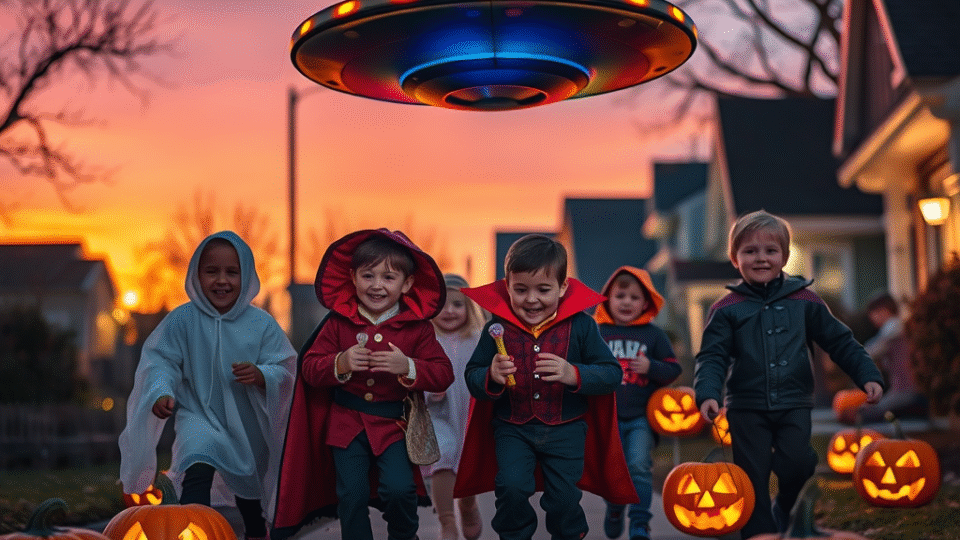
The Hitchhiker’s Guide to Halloween
Halloween (also known as “All Hallows’ Eve,” “Samhain,” or “That Night When Americans Accidentally Give Their Dogs Chocolate”) is an Earth festival held annually on October 31st, primarily celebrated in regions where humans have decided that autumn isn’t quite unsettling enough on its own.
The event has its origins in ancient Celtic traditions, which were subsequently adopted, adapted, and thoroughly confused by various religious groups until nobody could quite remember what they were celebrating anymore—a state of affairs that bothers precisely no one, as it turns out.
The Basic Premise
The fundamental concept is delightfully simple: humans, particularly small ones, dress up in costumes representing things that should theoretically be frightening (ghosts, vampires, their parents’ tax returns) and then wander from dwelling to dwelling demanding confectionery under thinly veiled threats of property damage. This practice, known as “trick-or-treating,” is one of the few occasions in Earth society where extortion is not only legal but actively encouraged.
Adults, meanwhile, use Halloween as an excuse to attend parties dressed as either “sexy [noun]” or “topical political figure,” categories which occasionally and disturbingly overlap. The amount of creative energy humans invest in making mundane objects provocative (sexy corn, sexy Tetris piece, sexy tax form) suggests a species with far too much time on its hands.
A Cautionary Tale: The Zygorthian Survey Incident
It is worth noting here the unfortunate case of Junior Xenobiologist Klaxtu-7 of the Zygorthian Expeditionary Fleet, who had the spectacularly poor timing to arrive on Earth for a routine population survey on the evening of October 31st, 1952.
Klaxtu-7, hovering approximately twelve meters above a suburban American neighborhood in their standard-issue reconnaissance pod, carefully documented what they believed to be Earth’s native population: miniature bipedal creatures of bewildering genetic diversity. Their field notes, later published in the Galactic Journal of Xenobiology (and subsequently retracted), made the following observations:
- The dominant species appeared to be small (average height: 1.2 meters) with wildly varied phenotypes
- One specimen possessed an orange spherical head with triangular facial features (later identified as a “pumpkin costume”)
- Another exhibited characteristics of Earth’s Chiroptera order but with fabric wings and inexplicable cape (vampire bat misidentification)
- A third appeared to be a hybrid of organic and mechanical components, silver in color (alleged “cyborg”; actually a child in aluminum foil)
- Multiple specimens of what appeared to be ambulatory bedsheets (ghosts)
Klaxtu-7 spent three hours documenting what they termed “the most genetically diverse species cluster in the known universe,” noting with particular alarm that despite their differences, all specimens exhibited identical behavior: approaching dwellings, producing ritualized vocalizations (“trick or treat!”), and receiving offerings of brightly packaged sustenance from larger beings who appeared to be their servants or possibly their livestock.
The junior xenobiologist’s report concluded that Earth was populated by a mysterious race of miniature polymorphs who maintained a servant class of tall, poorly-dressed bipeds. These servants, Klaxtu-7 theorized, had been so thoroughly domesticated that they willingly distributed their food supplies to their diminutive masters upon demand.
It wasn’t until Klaxtu-7 returned the following week for further study and found the streets populated entirely by the “servant class”—with not a single miniature polymorph in sight—that they realized something had gone catastrophically wrong. A hasty consultation with the Galactic Database revealed the truth about Halloween, though by then the paper had already been circulated to seventeen star systems.
Klaxtu-7 now works in the Zygorthian Archive Division, filing documents about planets with sensible, non-confusing cultural practices. They have requested never to be assigned to Earth again.
The incident has since become required reading at the Galactic Academy under the heading: “Why Temporal Context Matters in Xenobiological Field Research.”
Traditional Activities
Pumpkin Carving: Humans purchase large orange gourds called pumpkins, hollow them out, carve faces into them, and place candles inside. The resulting jack-o’-lanterns allegedly ward off evil spirits, though their primary function appears to be creating fire hazards on porches and providing squirrels with convenient housing. They may also confuse alien researchers into believing Earth is populated by sentient vegetables.
Horror Films: Citizens gather to watch fictional depictions of terrible things happening to other fictional citizens, finding this “entertaining” rather than “a troubling psychological indicator.”
Haunted Houses: Elaborate structures where humans pay actual currency to be jumped at by other humans wearing masks and wielding chainsaws (usually fake). The fact that people voluntarily queue for this experience tells you everything you need to know about Earth psychology.
Apple Bobbing: A game where participants plunge their faces into water-filled containers to retrieve apples using only their teeth. This tradition predates modern germ theory and continues despite it.
Candy Economics
The Halloween economy operates on a fascinating principle: adults purchase enormous quantities of miniature candy bars—approximately 70% of which they intended to give away and 30% of which they plan to “accidentally” keep for themselves. By November 1st, the average Earth household contains enough sugar to fuel a small space vessel, most of it consumed by children who will spend the next several days operating at velocities approaching light speed.
Dental professionals regard Halloween with mixed emotions: horror at the cavity implications, but deep appreciation for the reliable income stream.
Costume Controversies
Each year, humans engage in spirited debates about which costumes are “appropriate,” “offensive,” or “just trying too hard.” These discussions typically reach fever pitch around mid-October and are completely forgotten by November 2nd, only to repeat with fresh outrage the following year. Anthropologists believe this ritual serves an important social function, though they’re not quite sure what it is.
The Philosophical Conundrum
Halloween presents a curious paradox: humans spend 364 days teaching their offspring not to take candy from strangers, then dedicate one entire evening to doing precisely that. When asked about this inconsistency, most humans simply shrug and say “it’s tradition,” the universal explanation for activities that make no logical sense.
Modern Developments
In recent decades, Halloween has evolved to include “trunk-or-treating” (trick-or-treating, but in parking lots), elaborate neighborhood decorations that rival some planets’ defense systems in complexity, and social media documentation that takes longer than the actual festivities.
Some Earth communities have also introduced “teal pumpkins,” indicating households offering non-food treats for children with allergies, proving that even in a festival dedicated to chaos, humans will find ways to be thoughtful and inclusive—which is, frankly, rather touching for a species that also invented nuclear weapons.
Final Notes
Halloween essentially allows humans to confront their fears of death, darkness, and the supernatural by turning them into parties, proving once again that Earth’s dominant species will celebrate literally anything if you add enough sugar and give them permission to wear impractical clothing.
Off-world visitors should note: if small humans in costume appear at your spacecraft door demanding “treats,” complying is advisable. They travel in packs, and their parents are watching. Also, please conduct reconnaissance missions on multiple dates before filing official xenobiological reports. The Galactic Archive’s credibility can only withstand so many retractions.











Leave a Reply